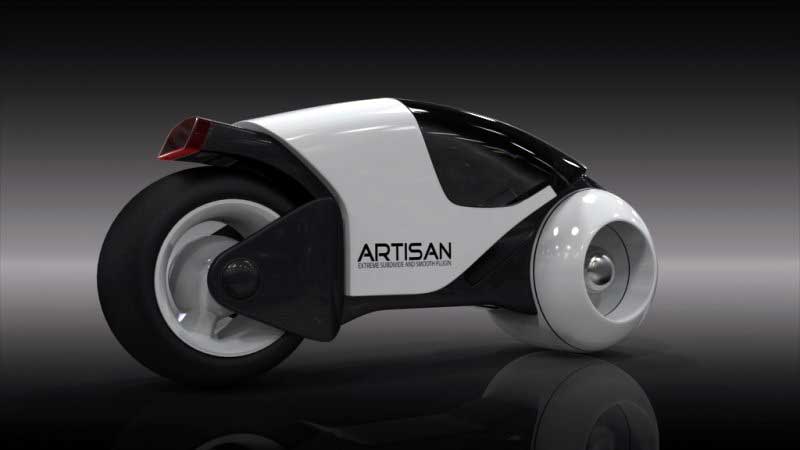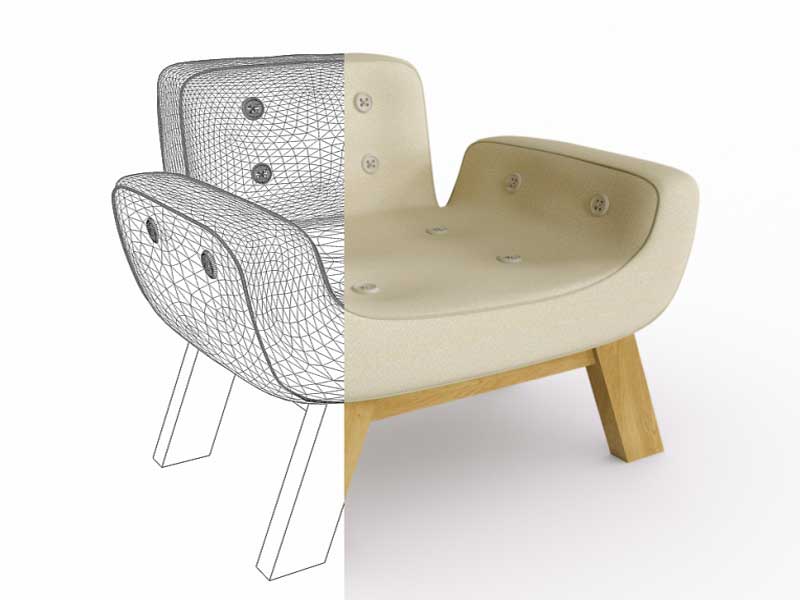Dale Martens and Artisan 2 – organic SketchUp?

Dale Martens has been writing SketchUp plugins for many years now and is well known for many popular free and commercial plug-ins that have extended Trimble SketchUp’s abilities as a 3D modeling application. As dale says “We’ve been developing SketchUp plugins since 2005 and our top quality extensions are currently being used by tens of thousands of users worldwide in industries such as architecture, interior design, construction, urban planning, film and game design (to name a few).
As we all know, SketchUp’s ability to deal with ‘organic shape modeling’ has been a bit of an issue for awhile now, especially in the early days, but this is where this latest SketchUp plugin, Artisan, comes into play. SketchUpArtists managed to grab an interview with Dale, the creator of Artisan, and gently ‘grilled’ him on Artisan’s abilities as a sculpting plugin alternative for SketchUp.
Interview – Artisan and Dale Martens
Please introduce yourself and tell us bit about yourself and your background?
Currently, I live in a small town in Saskatchewan, Canada called Hepburn. I have a degree in Civil Engineering and was a Structural Engineer for about 8 years up until May 2011 after which I decided to pursue a new career in the 3D visualization industry and also devote more time to writing SketchUp plugins.
When did you first become interested in writing plugins?
A big part of me always wanted to become a computer programmer. I probably started programming around the age of 8 or 9 but (for some weird reason) I decided not to pursue it in college. Writing plug-ins has allowed me to continue my programming interest in a fun and relaxing way where I have the freedom to develop whatever I want.
How long have you been developing and writing SketchUp plugins for?
I started my first plug-in, SkIndigo, in 2005. At the time, I was toying with the idea of starting a visualization side business and I stumbled onto SketchUp and Indigo Renderer. I immediately loved both of these applications but there was no way to render from SketchUp to Indigo. Therefore, I decided to try writing an exporter myself (which of course became SkIndigo). It was quite a challenge since I had no knowledge of Ruby or the SketchUp API at the time, plus, I had very little formal programming education (something that still holds me back to this day). However, once I got into it, I was hooked.
Which of your plugins are you most proud of, both free and commercial?
I am most proud of Artisan (commercial) and SkIndigo (free). With Artisan, I am most proud of the ability it gives to SketchUp users to freely model in ways that the native tool set does not allow. Many of the features in Artisan are long-standing feature requests that will likely never be implemented into the SketchUp core application. They are features that I myself always wanted to see in SketchUp and it feels great to have implemented so many of these in one plug-in package.
With SkIndigo, I am very proud of the sophisticated user interface that was developed using Ruby and HTML Web-dialogs. In addition, I found creative ways to solve problems and add cool features even though my programming knowledge was quite limited.
Where did Artisan blossom from?
Artisan is actually the follow-up to my popular plug-in, “Subdivide and Smooth” (SDS) which is still available at Smustard.com. When I began work on Artisan, it became apparent that this plug-in would become much more than just a subdivision plug-in. I was able to re-use a lot of the subdivision code from SDS, although in Artisan, I optimized and enhanced every original feature that was included in SDS and added lots of new features including sculpting, soft selection, soft move, soft rotation, polygon reduction and make planar.
I had considered making the sculpting and soft transformation tools as separate plug-ins from the subdivision tools but I found that all of these tools complemented each other so well that it just made sense to make it all into one package.
How did you come up with its name?
I felt that ‘Subdivide and Smooth 2’ was a bit too long and did not really capture the essence of the plug-in. The name ‘Artisan’ means ‘craftsman’ and reflects the user’s new freedom to create models in SketchUp that may not have been possible before inside of SketchUp. A name like ‘Artisan’ is also not specific to a certain feature of the plug-in which allows me to add any type of feature to it without having to change the name again.
What amount of work actually goes into developing a commercial plugin, like Artisan?
Artisan was in development for about two years during my spare time. There were months when I did not work on it at all but then there would be long stretches where I would work on it 4-5 hours each day. I did not count the number of hours I put into it but it would definitely be measured in the 100’s and I wouldn’t be surprised if it was over 1000 hours (not including the time that was spent on the original SDS plug-in)
People may not realize that probably over 50% of the work on a commercial plugin is all of the extra testing, optimizing, and user interface tweaking that goes into it.
How positive has the reaction been so far to this current release of Artisan?
I think it’s been extremely positive. Artisan has been out for awhile now (since Feb. 28, 2011) and I am still getting emails from new users who are just thrilled about what they are finally able to do in SketchUp. Let’s face it, everyone has their favorite modeling application and even though the features in Artisan are available in other apps, people who love SketchUp will almost always prefer to work within SketchUp as much as possible rather than always switching back and forth between apps, exporting, and importing…it’s a big pain and can lead to really messy problems.
There is some competition, both free and commercial in this area of sculpting tools, but how is Artisan different from the rest of the competition on the block?
Artisan works well and it does it all inside the latest version of SketchUp without having to deal with the import and export mess that you would get using an external application. I think users will really appreciate the extra effort that I put into it to make it feel like an extension of SketchUp. I tried very hard to make the interface intuitive and ‘feel’ like SketchUp and not a plugin. It works how you expect it to work. Artisan’s code is optimized which means that it is much faster than the free plugins and is much more stable. A lot of thought goes into the efficiency of the workflow. I use Artisan all the time in my 3D modeling and visualization business so it’s also to my advantage (as well as yours) to make the plug-in as efficient and easy to use as possible.
With Artisan, you also get customer support directly from me.
Which particular areas do you think Artisan really excels in?
It’s just awesome for terrain modeling! I am really proud of the new sculpting tools which allow you to deform a model in many different ways just by dragging your mouse across it. These tools add a whole new way to be creative within SketchUp. You can sculpt, smooth, flatten, pinch, and inflate by using virtual brush strokes.
As I said before, Artisan is easy to use and faster than the free plug-in alternatives. Everything works and is very stable. The subdivision algorithm can handle the most horrendous geometry that you can throw at it. The entire plug-in is very robust.
What makes Artisan such a joy to use (I’m speaking from my own experience) is that it has all of the tools you need to create free-form geometry all in one place. There are some great free plug-ins out there but it’s so much nicer to have full set of solid organic modeling tools that you know will work instead of searching around the internet for a bunch of free plugins, each with their own interface and idiosyncrasies that you will have to learn and get used to.
What other tools does Artisan offer apart from sculpting?
Sculpting is only one piece of the puzzle. With Artisan, you also get enhanced subdivision surfaces modeling, mesh smoothing, creasing, selection painting, material painting (drag across faces to apply materials), vertex editing, soft selection, soft move, soft rotate, make planar, and polygon reduction.
Artisan 2 is an extension for SketchUp that lets you do the impossible! With powerful tools for subdivision, sculpting, soft selection, free-form deformation, extrusion, and more, Artisan will supercharge your ability to model terrain, characters, furniture, and other complex organic forms.
Artisan 2 Organic Toolset for SketchUp
Subdivision: New in Artisan 2 is the ability to model using real-time subdivision modeling where the subdivided surface gets updated in real-time as you make edits.
Transform: Perform soft transformations and maintain quads using automatic folding and healing, all in real-time.
Sculpt: The improvements to the sculpting tools have to be seen to be believed! Auto-Add Detail, new brushes, and easier symmetry give you the ability to sculpt anything you can imagine!
Terrain: The Artisan 2 Grade Brush is a revolutionary new tool for accurately grading terrain in SketchUp! Easily control both slope and direction!
Features Include:
Subdivision Surfaces
- Robust subdivision algorithm that can handle very complex geometry and is not limited to quads and triangles
- Subdivide and smooth selected faces, groups, or components
- Crease edges or vertices to create hard edges and points
- Knife subdivide tool for creating loops
- Extrude tool to create loops without interior faces
- Low-poly
- Proxy Mode that automatically updates the subsurface geometry as you edit
- Auto-subdivision of selection boundary faces that results in cleaner meshes after sub dividing
- Quickly preview subsurface geometry prior to committing
- Proper interpolation of UVs for subdivided geometry
Brush Tools
- Sculpt Brush (sculpt, pinch/spread, flatten, inflate/deflate, smooth/jitter)
- Select Brush (select faces by performing strokes)
- Paint Brush (paint SketchUp materials on faces using virtual brushstrokes)
- Symmetrical sculpting mode using with user-defined work plane
- Lock vertices to user-defined work plane
Vertex Transformation Tools
- Soft Selection
- Soft Move, Rotate, and Scale
- Make Planar (XY, XZ, YZ, or best fit)
Mesh Optimization (Polygon Reduction)
- Reduce the number of polygons in a complex mesh while maintaining details
Checkout Dale’s website mind.sight.studios for more images and information at Artisan…
Learn how to model Chipp Walter’s Tron Lightcycle (1st image) using SketchUp and Artisan with this collection of video Tutorials.















very interesting and nice Q and A. I managed to peep a bit on the life of one of the best script writer with sketchup.
Dale, great stuff indeed ! Now all we need is your kind of intuitive touch on the blending of sketchup with its wierdly overlapped cousin, Layout , ( or an artisan like one stop shop script so we have the complete 3d program in one package!
Any thoughts on this ?